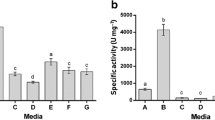Abstract
The studies have revealed alkaline exoinulinase produced by haloalkaliphilic phototrophic bacteria Ectothiorhodospirea mobilis Al-2 for the first time. A new method for the isolation of a homogeneous exoinulinase from the culture broth was developed and the properties of this enzyme have been investigated. It was shown that specified exoinulinase in contrast to the studied exoinulinases produced by microorganisms exhibits catalytic activity at the wide range of pH (7.0–10) and a temperature (20–60 °C) with a maximum of the inulolitic activity at pH 9.0 and 50 °C. The studied exoinulinase possessing also invertase activity (I/S1.4) is a monomeric protein with molecular mass 57Kda, as well as Km and Vmax for inulin 3.8 mM/ml and 10 µmol/ml/min−1, respectively. The studies of the influence of different metal ions on enzyme activity have shown that Mn+2, Cu+2, Co+2, Mg+2, NaCl 5–7% promote relatively higher catalytic activity while Zn+2, Cu+2 and Fe+2 partially suppress the enzyme activity and Hg2+completely inactivates the enzyme.
The formation of only fructose and glucose at the enzymatic hydrolysis of inulin confirms that the studied exoinulinase belongs to the exo-type of enzymes. The obtained results supplement our fundamental knowledge in biochemistry-enzymology, as well as the biodiversity of microorganisms expressing exoinulinase. The studied exoinulinase exhibits activity at salinity of the medium and can potentially be used in the biotechnology of inulin bioconversion into bioproducts under alkaline conditions.










Similar content being viewed by others
Data availability
All data are presented in the manuscript.
References
Ai-Xia Li, Guno LZ, Wei-Gong Lu (2012) Alkaline inulinase production by a newly isolated bacterium Marinimicrobium sp.–A18 and inulin hydrolysis by the enzyme. World J Microbiol Biotechnol 28:81–89. https://doi.org/10.1007/s11274-011-0794-3
Aruna K, Hati A (2014) Optimization of inulinase production by Bacillus sp B51f isolated from Rhizosphere of Agava sisalana. Int J Pure Appl Biosci 2(3):161–176
Chesini M, Paola L, Parra DF, Rojas NL, Carlos J, Cavalitto SF, Ghiringhelli PD, Hours RA (2013) Aspergillus kawachii produces an inulinase in cultures with jacon (Smallanthus sonchifolius). Electron J of Biotechnol 16(3):1–8
Chi Z, Zang T, Cao T, Liu X, Cui W, Zhao C (2011) Biotechnological potential of inulin for bioprocesses. Bioresour Technol 102:4295–4303. https://doi.org/10.1016/j.biortech.2010.12.086
Gupta AK, Nagpal B, Kaur N, Singh R (1988) Micelial and extracellular inulinases from Fusarium oxysporum grown on aqueous extract of Cichorium intybus roots. J Chem Technol Biotechnol 42:69–76. https://doi.org/10.1002/jctb.280530310
Gupta AK, Singh DP, Kaur N, Singh R (1994) Prodaction, Purification and Immobilization of Inulinase from Kluyveromyces fragilis. J Chem Technol Biotechnol 59:377–385
Laowklom N, Chantanaphan R, Pinphanichakarn P (2012) Production, purification and characterization of inulinase from a newly isolated Streptomyces sp. CP01. Natural Resources 3:137–144
Nascimento DS, Valasqes Junior G, Fernandes P, Riberio GC, Lime DM, Goes-Neto A, Oliveria RQ, de Cassia R, Ribeiro F, de Assis SA (2012) Production, characterization and application of inulinase from fungal endophite CCMB 328. Anais Da Academia Brasileria De Ciencias 84:2–9. https://doi.org/10.1590/s0001-37652012005000035
Neagu C, Bahrim G (2011) Improved inulinase activity by penicillium purpurogenum grown in microwave pretreated coffee spent by L16 orthogonal design of experiment. Innov Rom Food Biotechnol 9:1–11
Onodera S, Shiomi N (1988) Purification and Substrate Specifity of endo-type Inulinase from Penicillum purpurogenum. Agric Biol Chem 52(10):2569–2576
Pandey A, Soccol CR, Selvacumar P, Soccol VT, Krieger N, Fontana JDN (1999) Recent developments in microbial inulinasees: its production, properties and industrial application. Appl Biochem and Biotechnol 81:35–52. https://doi.org/10.1385/abab:81:1:35
Pariviguna V, Saravan P, Shanmugham K (2019) Characterization of inulinase from Aspergillus niger AM270052.1 and scale up of conditions for mass production. Int J Pharm Biol Sci 9(3):395–404
Pessoni RAB, Braga MR, de Cássia L, Figueiredo-Ribeiro R (2007) Purification and properties of exo-inulinases from Penicillium janczewskii growing on distinct carbon sources. Mycologia 99(4):493–503
Rohban R, Amoozeger MA, Ventoza A (2009) Screening and isolation of halophilic bacteria producing extracellular hydrolyses from Howz Soltan Lake Iran. J Ind Microbiol Biotechnol 36:333–340. https://doi.org/10.1007/s10295-008-0500-0
Singh P, Gill P (2006) Production of inulinases: recent advances. Food Technol Biotechnol 44:151–162
Singh RS, Singh T, Hassan M, Kennedy JF (2020) Updates on inulinases: structural aspects and biotechnological applications. Int J Biol Macromol 164:193–210. https://doi.org/10.1016/j.ijbiomac.2020.07.078
Somogy M (1952) Notes on sugar determination. J Biol Chem 195:19–23 (PMID: 14938350)
Vandamme EJ, Derycke DC (1983) Microbial inulinases: fermentation process, properties and applications. Adv Appl Microbiol 29:139–176. https://doi.org/10.1016/s0065-2164(08)70356-3
Weber K, Osborn M (1969) The reliability of molecular weight determinations by dodecyl sulfate-polyacrylamide gel electrophoresis. J Biol Chem 224:4406–4412
Zhi C, Chi Z, Zhang T, Liu G, Yue L (2009) Inulinase-expressing microorganisms and applications of inulinases. Appl Microbiol Biotechnol 82:211–220. https://doi.org/10.1007/s00253-008-1827-1
Funding
The authors declare that no funds, grants, or other support were received during the preparation of this manuscript.
Author information
Authors and Affiliations
Contributions
All authors contributed to the study’s conception and design. Material preparation, data collection, and analysis were performed by LM and AV. The first draft of the manuscript was written by LM and all authors commented on previous versions of the manuscript. All authors read and approved the final manuscript.
Corresponding author
Ethics declarations
Conflict of interest
The authors declare that they have no conflict of interest.
Additional information
Communicated by Atomi.
Publisher's Note
Springer Nature remains neutral with regard to jurisdictional claims in published maps and institutional affiliations.
Rights and permissions
Springer Nature or its licensor (e.g. a society or other partner) holds exclusive rights to this article under a publishing agreement with the author(s) or other rightsholder(s); author self-archiving of the accepted manuscript version of this article is solely governed by the terms of such publishing agreement and applicable law.
About this article
Cite this article
Markosyan, L., Vardanyan, A. Properties of the extracellular alkaline inulinase produced by haloalkaliphilic phototrophic bacteria Ectothiorodospirea mobilis. Extremophiles 27, 29 (2023). https://doi.org/10.1007/s00792-023-01315-1
Received:
Accepted:
Published:
DOI: https://doi.org/10.1007/s00792-023-01315-1




